Growing Young Gardner's Club.
Lessons Begin, seeds sprout, weeds emerge.

The Growing Young Gardeners Club
met for the second session at Wheeler Park on 1100 Dorset Street in South Burlington, Vermont on June 18, 2015.
 The Growing Young Gardeners Club is collaboration with the Machia Wilderness Camp and the Burlington Garden Club.
The Growing Young Gardeners Club is collaboration with the Machia Wilderness Camp and the Burlington Garden Club.
Lessons begin, seeds sprout, weeds emerge.
Critters start harvest early, more seeds planted.
 |
| Gather-round young gardeners. Let us view what has progressed since you last tended your garden. |
Thinning the Rutabaga consisted of spreading two fingers apart then thinning out plants in-between the two fingers. The young gardeners admitted they did not mind thinning these young plants because another group of kids planted them.

Most of the new plants did well over the last week, with good germination of planted seeds, and the seedlings taking well to their new home.
However, we did observe some damaged plants with partially chewed leaves and some plants with nothing left but stems (broccoli). Something or somebody has a taste for very young broccoli, kale, and corn plants.
 We will leave the leafless broccoli to see if it recovers but also plant some more broccoli seed. Kohlraibi Gigante seeds dropped into their new home next to the half eaten broccoli plants. The seeds are very small, yet this heirloom bulb plant will get as big as 10 inches in diameter and 10 lbs.
We will leave the leafless broccoli to see if it recovers but also plant some more broccoli seed. Kohlraibi Gigante seeds dropped into their new home next to the half eaten broccoli plants. The seeds are very small, yet this heirloom bulb plant will get as big as 10 inches in diameter and 10 lbs. Meanwhile a centipede raced by the broccoli raised bed and quickly found a hiding place under the mulch. We imagined it must be an enormous chore for the centipede and especially its cousin the millipede to tie its many shoelaces, given that it has so many legs, therefore so many feet, therefore so many, many sneakers. Perhaps they are Velcro ties!
The children quickly went to work in detective mode to determine the likely culprit who ate some of the new plants.
Critter footprints lead from the fence and on through some of the raised beds. Two nearby resident groundhogs quickly became prime suspects.
Detective work continued, exposing disturbed soil near the fence indicating a few weak spots in the perimeter defense fence.
Plans were made to fortify the garden fortress to help keep the varmints and vermin out.

Beans, squash, and corn are the three sister plants. "I learned that from the Indians" one young gardener proudly proclaimed. Pole beans grow up the corn stalks. Squash grow around the base and having prickly stems and creating a dense mat, they discourage animals from eating the beans.
 |
| Heirloom lettuce seed was planted in between the bean rows. |
A few weeks ago the young gardeners planted extra seeds because they did not know what the germination rate would be.
Beets came up in bunches. This town is only big enough for one of us, fellas. So the thinning process begins. Then the soil around the survivor is firmed up so it is not wobbly and sad about losing its neighbors.
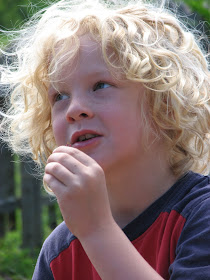 |
| Tasting the young beet plants that were thinned out of the garden. |
 |
| Yup, sometimes we disturb one of these hard working subterranean creatures. |
 |
| Fennel |
 |
| Smiles and sun warm the day. |
 |
| Some insects are harmful to veggies, some are beneficial, and some are benign like this one. Still, the little fella (Boxelder bug) was fun to watch and kind of artsy too. |
 |
| Some lessons are best learned hands on. We learned that this thistle plant has thorns. We will whistle next time we find a thistle. And wear gloves to pull it up. |
 |
| Squeeze the Fennel through your fingers and then smell the aroma. |
 |
| The fennel smells like Strawberry Jelly beans. |
 |
| Now try the tomato plant. |
Watering in - Transplants in particular need watering in to help the disturbed soil clump together, become more compact. And it reduces the air pockets so the plant can feed well.
That about sums up our learned lessons for this session.
One side note - the person taking photographs learned a lesson too. Do not lose a green pen in a garden area- tough to spot!
 |
| Writing our garden journal. |
JOURNAL TIME
Click here to view issue # 2 Growing Young Gardeners. Week 1 Hands and Seed(lings) meet soil. (many photos)
Bernie publishes short stories and photos reflecting Vermont values of Green and Clean and Community.


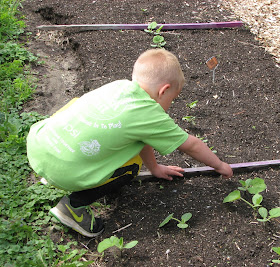














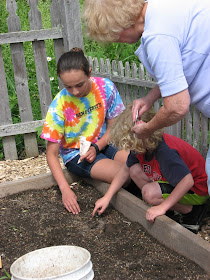




























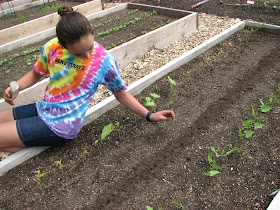






















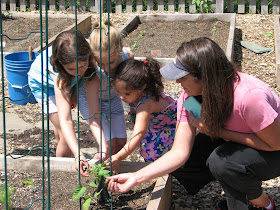











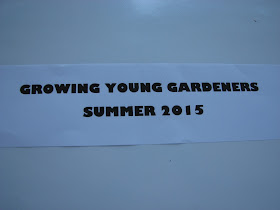

No comments:
Post a Comment
COMMENTS WELCOMED